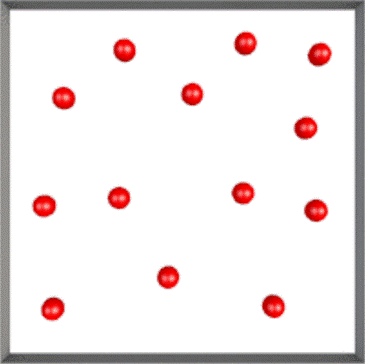Mean squared displacement: quantifying gelation, microstructure, and viscoelastic behavior
The mean squared displacement (MSD) is a direct result of a DWS measurement. It represents the displacement amplitude of particles in the system as a function of time and therefore, quantifies their motion in the sample. Two cases can be distinguished:
In a purely viscous sample, particles are free to move according to Brownian motion. Their displacement will thus increase linearly with time. This results in a particle MSD that is linear with time (see the figure below):

Fig. 4: MSD of a purely viscous sample. Fast or slow motion is determined by the size of the particles (smaller particles exhibit faster dynamics, while larger particles diffuse more slowly, considering the same solvent), or by the viscosity of the sample (particle motion will be slower in a highly viscous sample, than in a less viscous one). (Right) Particles freely diffuse in purely viscous liquids and can explore the whole sample.
The slope of the MSD can be directly related to the particle diffusion coefficient:
With
Fitting the measured MSD with these equations yields the viscosity η of a Newtonian solvent containing tracer particles of known radius R. However, in materials that also contain elastic components, the MSD shows a more complex time dependency, which makes the above equations not generally applicable.
In a viscoelastic sample, the displacement of the particles will increase linearly at short lag times, as long as they are only “feeling” the solvent. With time increasing, their motion will be hindered by the presence of a microstructure in the sample (e.g. a gel network). The diffusion process will then slow down. This is characterized by a change of slope in the MSD, which is non-linear.

Fig. 5:(Left) MSD of a viscoelastic sample. The non-linearity illustrates the dependency of particle motion, to the presence of a microstructure. At short lag times, particles “feel” only the solvent, while at longer lag times, their motion is restricted. (Right) Particles trapped in a gel network.
In some cases, the displacement may reach a plateau with amplitude corresponding to the maximal displacement, indicating a solid-like behavior originating from the presence of a stiff microstructure, where the particle motion is fully restricted – the particles are trapped in the “cages” formed by the network. In cases of a more flexible structure, the particle motion is not fully hindered and the MSD increase may be only slowed down.
At higher decay time, one may also see a further increase of the MSD: the particles are able to diffuse out of the network. The increase then follows a linear shape, whose slope can be related to the macroscopic viscosity of the system.
The MSD thus provides a wealth of information on a sample, without requiring knowledge of any other parameter: it is possible to assess whether one is measuring a fully liquid, a viscoelastic system, or a viscoelastic solid. By following the MSD over time, concentration, pH, or any other parameter susceptible to inducing microstructural changes, it is possible to monitor processes such as gelation.
From a non-linear MSD, one can extract microrheological quantities through the Generalized Stokes-Einstein equation: please refer to the section “DWS microrheology”, or to Opening the black box - Equations of Microrheology.pdf for more details.
